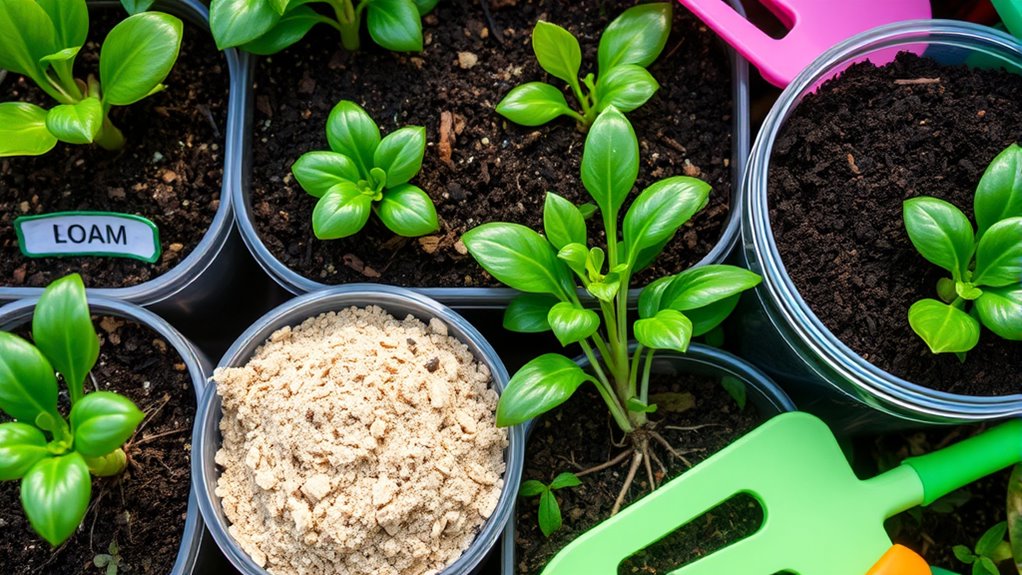When choosing the best soil mixes for thriving plants in your garden, I've found a few standout options. The Craft Aroid Potting Mix is perfect for tropical plants, while the Earth Science Wildflower Pollinator Mix promotes a vibrant ecosystem. For vegetable gardens, the Raised Bed Mix works wonders. Don't forget to check out Miracle-Gro's Potting Mix, which simplifies your watering routine. Stick around, and I'll share more excellent choices and factors to reflect upon for your plants!
Key Takeaways
- Choose potting mixes tailored to specific plant types, such as Craft Aroid for tropical plants and Miracle-Gro for general houseplants, for optimal growth.
- Look for organic and eco-friendly options like Back to the Roots Indoor Potting Mix that support sustainable gardening practices and promote healthy ecosystems.
- Ensure moisture retention and drainage capabilities with mixes like Miracle-Gro Moisture Control, which helps maintain consistent hydration while feeding plants for extended periods.
- Select nutrient-rich blends, such as Noot Potting Soil, that enhance nutrient absorption and support recovery for struggling plants.
- Consider mixes that provide excellent aeration and drainage, like Monstera Houseplant Potting Soil, to promote healthy root development and prevent overwatering issues.
Craft Aroid Potting Mix for Indoor Plants (1QT)
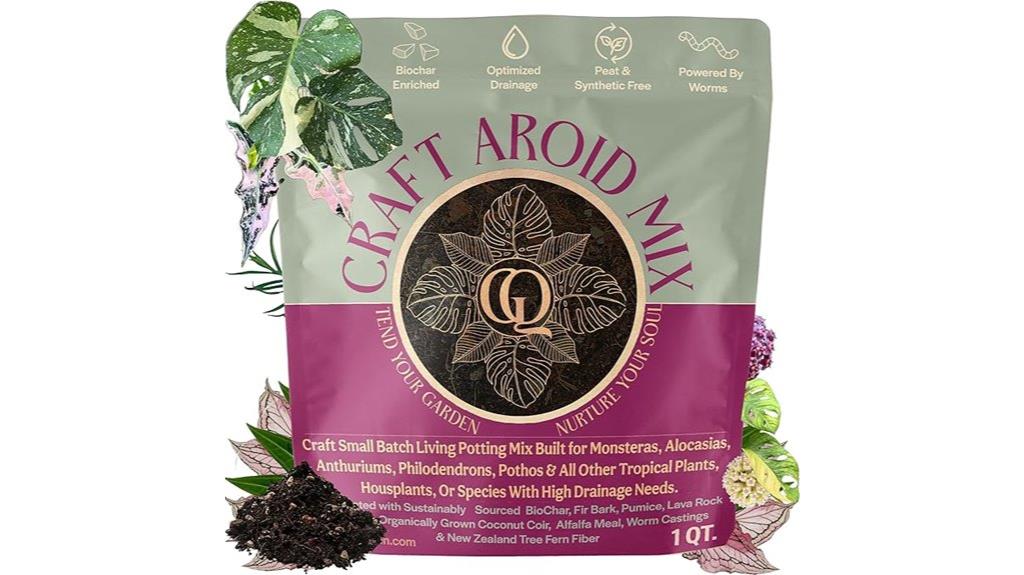
If you're a fan of tropical plants like Alocasia and Monstera, then the Craft Aroid Potting Mix for Indoor Plants (1QT) is just what you need. This nutrient-rich mix features eco-friendly pumice and lava rock, ensuring excellent drainage and aeration. I love that it's pre-mixed and ready to use, making potting a breeze. Plus, it's pet-friendly, which gives me peace of mind at home. I've noticed my plants thriving with vibrant leaves and rapid growth. The New Zealand Tree Fern Fiber helps maintain a pH of 6.0, mimicking their natural habitat. It's truly a game-changer for indoor gardening!
Best For: The Craft Aroid Potting Mix is best for indoor gardeners who are passionate about tropical plants such as Alocasia, Philodendron, and Monstera, and seek a high-quality, eco-friendly growing medium.
Pros:
- Nutrient-rich composition enhances plant health and promotes rapid growth.
- Chunky texture improves drainage and aeration, reducing the risk of overwatering.
- Pet-friendly ingredients provide a safe environment for households with pets.
Cons:
- Some users report plant decline and root death after using the mix.
- The performance may vary with different types of houseplants, leading to mixed experiences.
- Limited availability in larger quantities may necessitate frequent purchases for larger projects.
Earth Science Wildflower Pollinator Mix (6 lb)
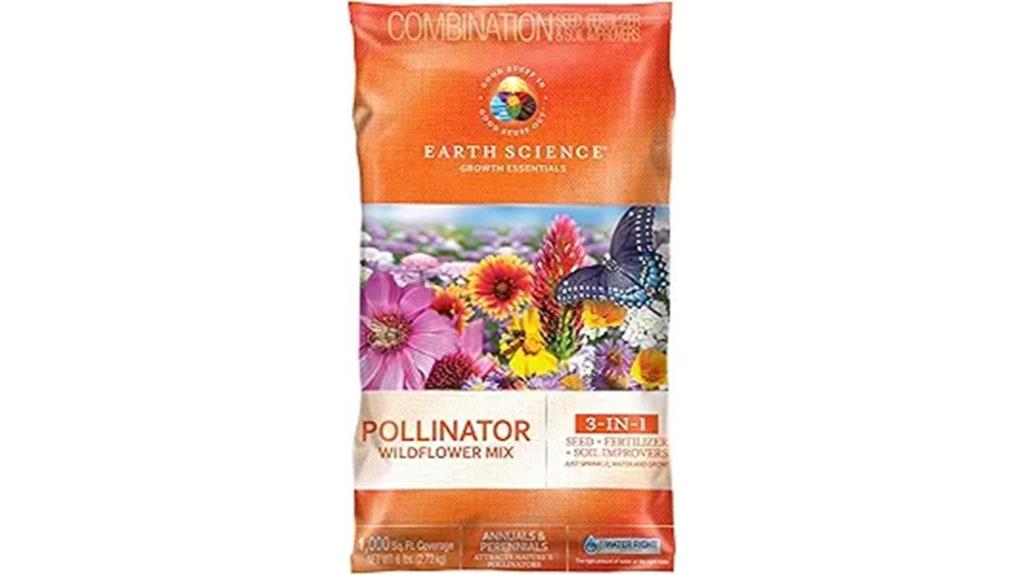
The Earth Science Wildflower Pollinator Mix (6 lb) is perfect for gardeners enthusiastic to attract a vibrant array of pollinators like bees and butterflies. This 3-in-1 mix combines wildflower seeds, plant food, and soil conditioners, making it a convenient choice. I appreciate that it's non-GMO and organic, ensuring a natural approach to gardening. Just remember to provide moderate watering for ideal growth. While some users have seen quick results, others noted that only 3% of the mix consists of wildflower seeds, leading to mixed experiences. Still, the potential to create a colorful pollinator haven is worth the try!
Best For: Gardeners looking to attract pollinators such as bees, butterflies, and hummingbirds with an easy-to-use wildflower mix.
Pros:
- Convenient 3-in-1 mix that combines wildflower seeds, plant food, and soil conditioners.
- Non-GMO and organic composition, promoting natural gardening practices.
- Reported quick growth by some users, with flowers returning in subsequent years.
Cons:
- Only 3% wildflower seeds in the mix, leading to a majority of inert matter.
- Variable success rates, with some users experiencing fewer blooms than expected.
- Regular watering required for optimal growth, which may be a drawback for some gardeners.
Raised Bed Mix Organic Gardening Potting Soil (20 Quarts)
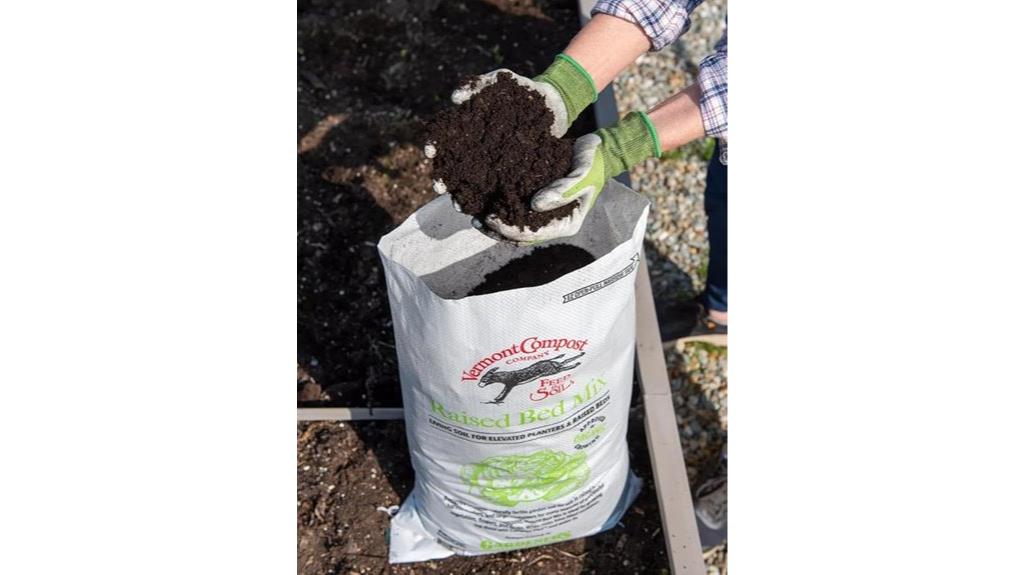
For anyone diving into organic gardening, the Raised Bed Mix Organic Gardening Potting Soil (20 Quarts) is a standout choice that excels in providing nutrient-rich support for your plants and vegetables. I've found it to be particularly effective for both indoor plants and outdoor garden planters. Many users share similar experiences, expressing satisfaction with its quality and usability. However, I did notice some concerns regarding foreign materials like metal bits, which could be an issue for some. Overall, its organic composition makes it a solid option for anyone committed to sustainable gardening practices.
Best For: Organic gardeners looking for a nutrient-rich potting soil suitable for both indoor and outdoor plants.
Pros:
- High-nutrient, compost-based formula that supports healthy plant growth.
- Organic composition makes it ideal for sustainable gardening practices.
- Ease of use noted by many users, enhancing the gardening experience.
Cons:
- Some users report foreign materials like metal bits and wooden markers present in the soil.
- Mixed initial results noted by a few users, indicating potential variability in performance.
- Time may be needed to fully evaluate its effectiveness in vegetable and flower gardens.
Earth Science Shady Wildflower Mix (6lb)
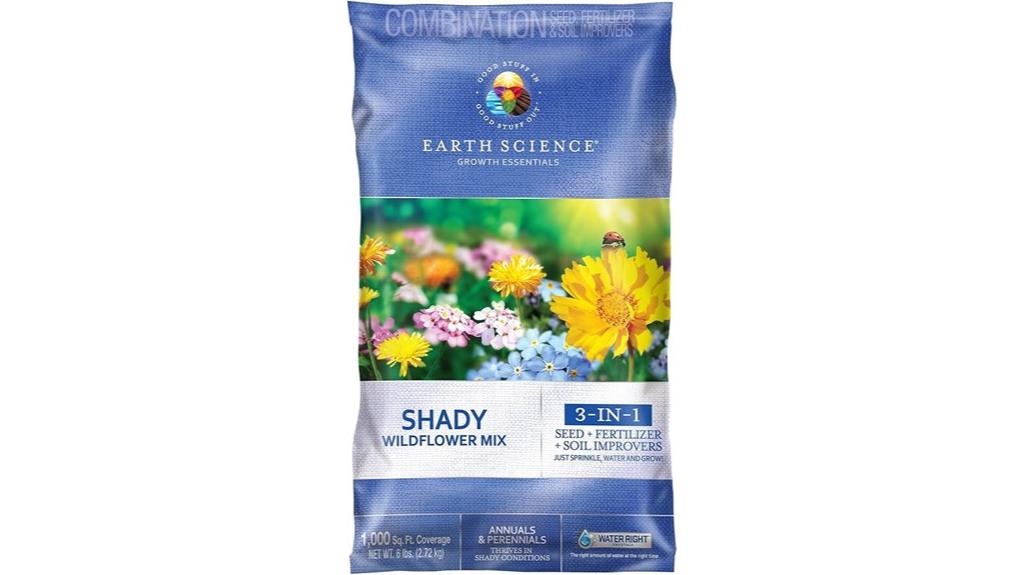
Looking to brighten up shaded areas in your garden? The Earth Science Shady Wildflower Mix is a fantastic choice! This 3-in-1 formula includes premium wildflower seeds, plant food, and soil conditioners. It covers approximately 1,000 square feet, making it perfect for larger spaces. With 13 species, like Chinese Forget-Me-Nots and Purple Coneflowers, it thrives in low-light conditions. Plus, it's safe for pets and the environment. I love the patented Water Right Crystals that indicate when to water. Just remember to plant after the last frost date for the best results. Your garden will flourish with minimal effort!
Best For: Gardeners looking to enhance shaded areas with low-maintenance wildflowers that support local wildlife.
Pros:
- 3-in-1 formula includes seeds, plant food, and soil conditioners for optimal growth.
- Non-GMO and safe for both pets and the environment.
- Patented Water Right Crystals provide a visual cue for watering needs.
Cons:
- Only about 1 ounce of actual seeds in a 6lb bag, which may be less than expected.
- Initial strong manure smell reported by some users.
- Requires 2-4 hours of sunlight per day, which may limit planting options in very shady areas.
Miracle-Gro Potting Mix for Container Plants (2-Pack)
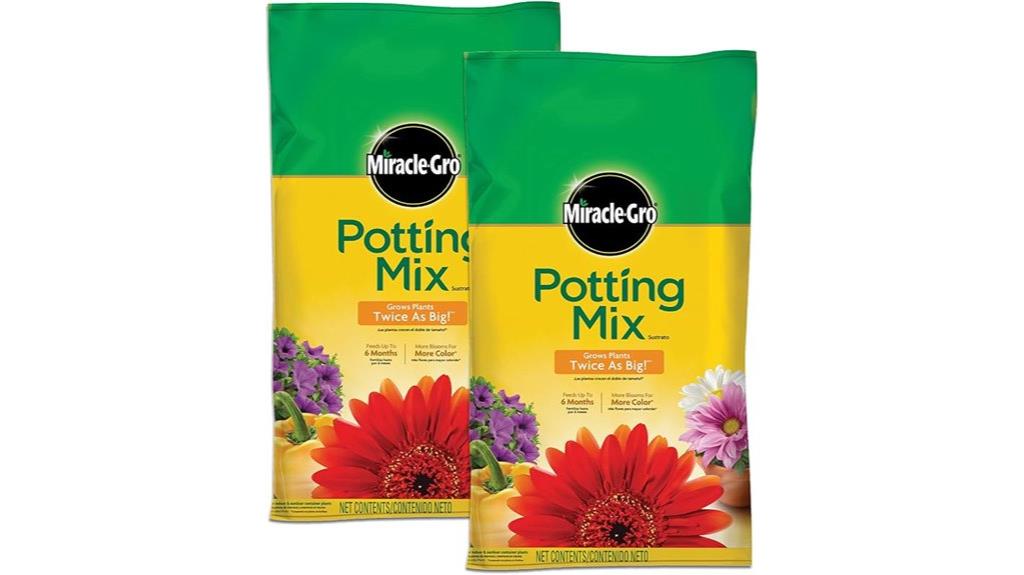
Miracle-Gro Potting Mix is an ideal choice for anyone wanting vibrant container gardens, whether you're nurturing flowers, vegetables, or shrubs. With two 8-quart bags, I find it perfect for filling multiple pots, accommodating various root sizes easily. This mix feeds plants for up to six months, resulting in growth that's twice as big compared to unfed plants! I appreciate that it retains water well, making my watering routine simpler. Plus, with a fantastic rating of 4.7 stars from thousands of reviews, it's no wonder this is a top choice for gardeners seeking consistent results. Give it a try!
Best For: Gardeners looking to grow vibrant container plants, including flowers, vegetables, and shrubs.
Pros:
- Retains water well, simplifying the watering process for busy gardeners.
- Provides nutrients for up to six months, promoting healthy and robust plant growth.
- Highly rated by customers, ensuring reliability and consistent results.
Cons:
- May require repotting annually to avoid soil compaction.
- Not suitable for pots without drainage holes, limiting pot selection.
- Some users may find it a bit heavy when handling larger quantities.
Burpee Premium Organic Potting Soil Mix (9 Quarts)
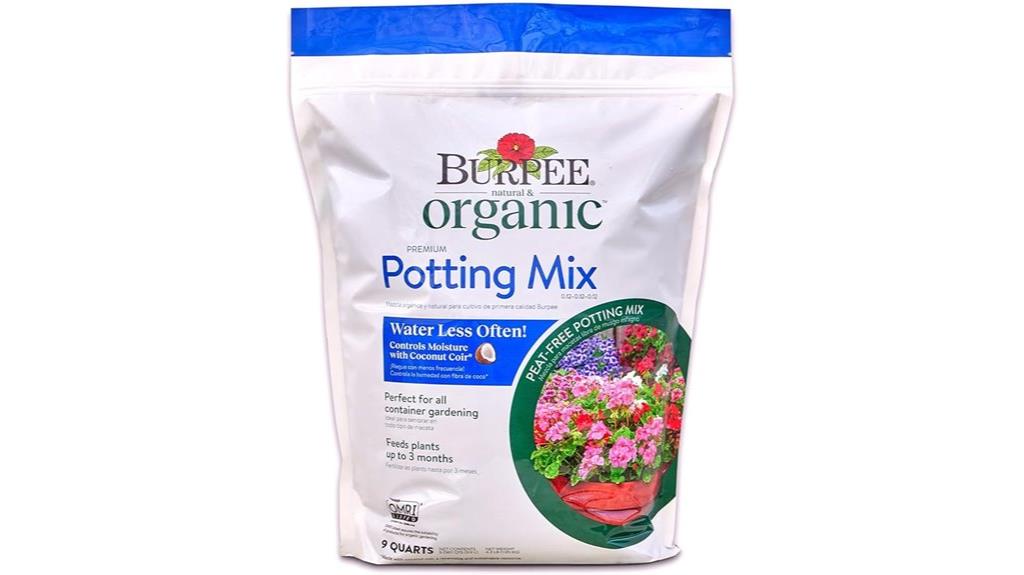
Burpee Premium Organic Potting Soil Mix (9 Quarts) stands out as the ideal choice for passionate gardeners seeking a blend that nourishes plants right from the start. This all-natural mix, enriched with sustainable coconut coir, promotes robust seed and root growth for flowers, vegetables, and herbs. Its excellent moisture retention guarantees your plants stay hydrated between waterings, while the slow-release nutrients support growth for up to three months. I've found it perfect for containers and raised beds, and the 100% satisfaction guarantee gives me confidence in my purchase. Customers rave about its performance, making it a top pick for indoor and outdoor gardening.
Best For: Passionate gardeners looking for an all-natural potting mix that promotes healthy growth in flowers, vegetables, and herbs.
Pros:
- Excellent moisture retention thanks to sustainable coconut coir.
- Provides immediate and slow-release nutrients for up to three months.
- Suitable for both indoor and outdoor gardening in containers and raised beds.
Cons:
- Some users report strong odors and dust upon opening.
- Improved packaging closure is needed to prevent spillage.
- A few customers experienced variations in soil quality.
Miracle-Gro Houseplant Potting Mix (4 qt.)
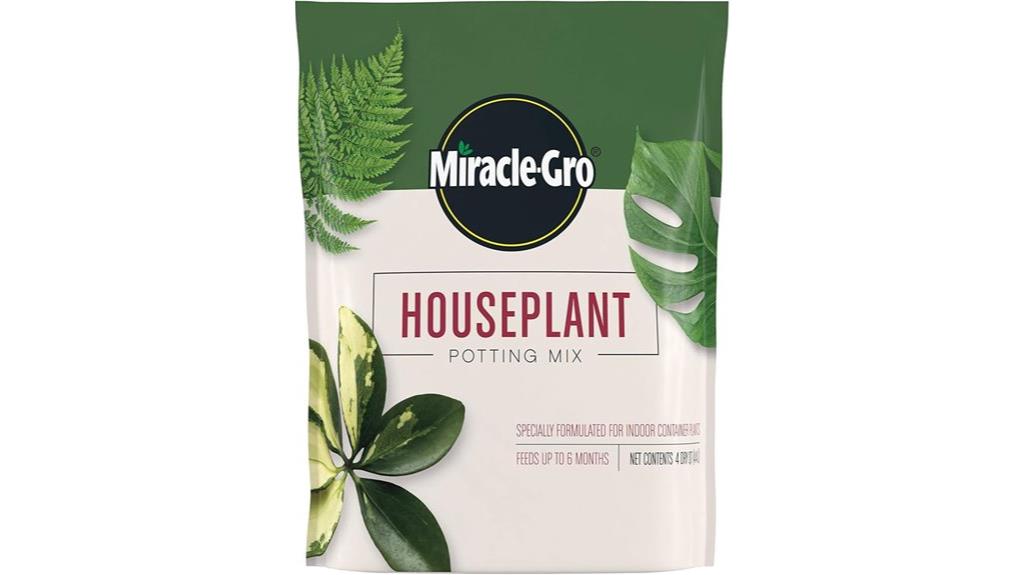
If you're seeking a reliable potting mix for your indoor plants, the Miracle-Gro Houseplant Potting Mix (4 qt.) stands out as an excellent choice. This mix is specially designed with perlite, sphagnum, and peat moss, ensuring ideal growth for houseplants like Pothos and Monstera. I appreciate how it reduces gnat issues while retaining moisture. Plus, it's fertilized for enhanced growth, making it suitable for succulents too. Users rave about their success with various plants after repotting. Just remember to start feeding with Miracle-Gro Plant Food 30 days after planting for the best results. It truly delivers on quality and performance!
Best For: Indoor plant enthusiasts looking for a high-quality potting mix to promote healthy growth in houseplants.
Pros:
- Fertilized blend enhances growth and supports a variety of indoor plants.
- Moisture-retaining components help reduce the frequency of watering and minimize gnat issues.
- Versatile usage suitable for both houseplants and succulents.
Cons:
- Limited size of 4 qt. may not be sufficient for larger projects or multiple repotting tasks.
- Initial feeding required after 30 days may be inconvenient for some users.
- Potentially higher price compared to generic potting mixes on the market.
Back to the Roots Organic Indoor Potting Mix (6 Quart)
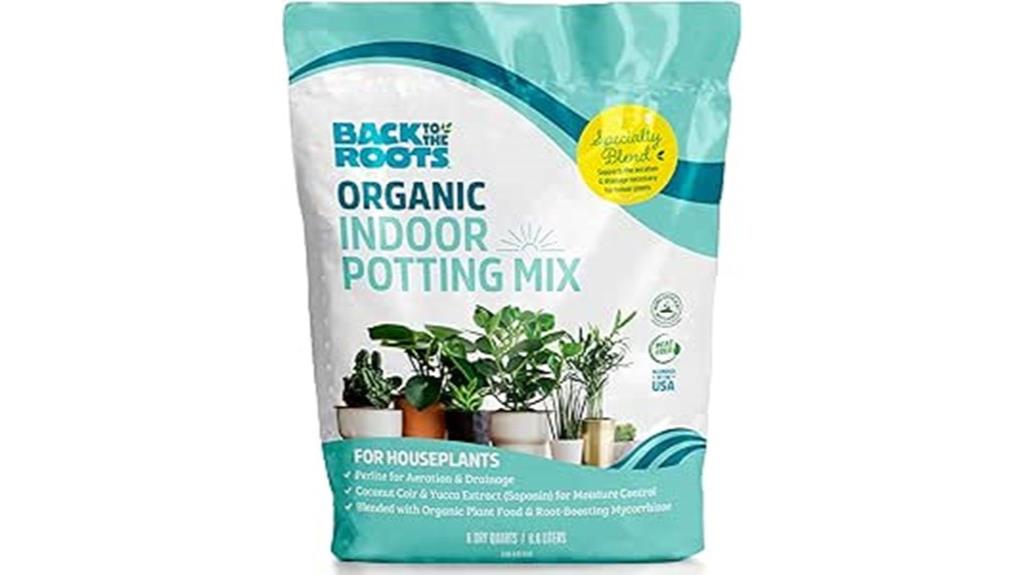
Back to the Roots Organic Indoor Potting Mix (6 Quart) stands out as an excellent choice for anyone seeking a natural, eco-friendly option for their houseplants. This 100% organic mix is made in the USA, peat-free, and promotes healthy growth. I love that it contains organic yucca extract, which helps retain moisture for my plants. The ROOT-BOOSTING MYCORRHIZAE enhance root development, making my plants thrive. Plus, it's safe for pets and people. While I've noticed some mushrooms sprouting, it just shows that healthy microorganisms are at work. Overall, I highly recommend this potting mix for vibrant, flourishing indoor plants.
Best For: Anyone looking for a natural, eco-friendly potting mix to promote healthy growth in their indoor plants.
Pros:
- 100% organic and peat-free, reducing environmental impact.
- Contains organic yucca extract for improved moisture retention and healthy plant growth.
- Safe for pets and people, minimizing indoor pest issues.
Cons:
- Some users may experience variations in texture and moisture levels.
- Occasional appearance of mushrooms, which may be concerning for some.
- Recommendations for quality control due to potential fungus or bugs.
Miracle-Gro Moisture Control Potting Mix (8 qt., 2-Pack)
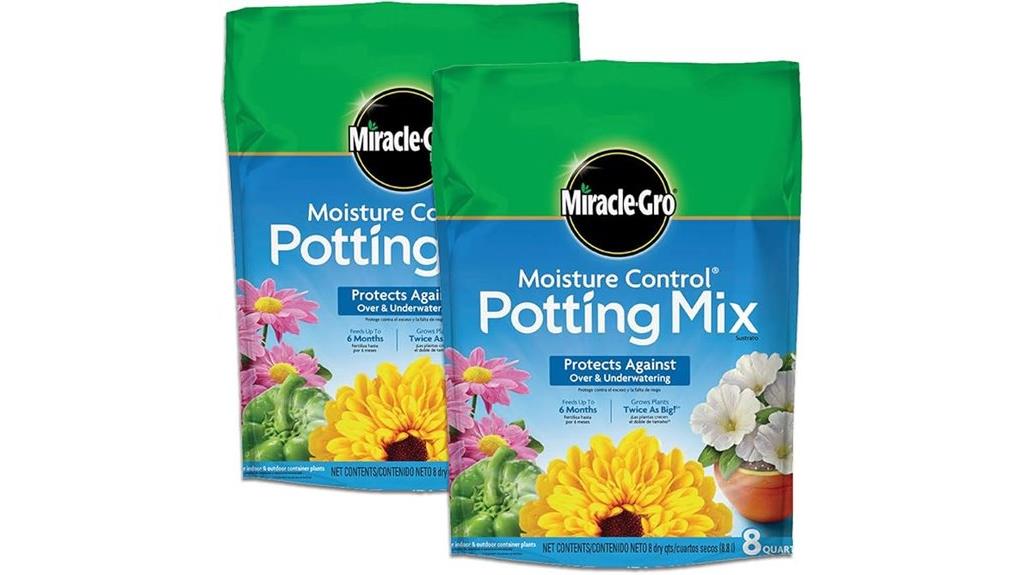
For plant owners who occasionally forget to water, Miracle-Gro Moisture Control Potting Mix (8 qt., 2-Pack) is an excellent choice. This mix absorbs up to 33% more water than standard potting soil, protecting my plants from the stress of over- and under-watering. With a blend of sphagnum peat moss, coir, and a wetting agent, it helps my indoor and outdoor plants thrive. Plus, it feeds them for up to six months, making maintenance easy. I've noticed my plants grow twice as big compared to those in unfed soil. Just be cautious when unpacking—some bags can be tricky!
Best For: Plant owners who occasionally forget to water and want a reliable potting mix that supports plant growth.
Pros:
- Absorbs up to 33% more water than basic potting soil, reducing the risk of over- and under-watering.
- Feeds plants for up to 6 months, simplifying maintenance and promoting healthier growth.
- Positive customer feedback highlights effectiveness in rejuvenating plants and ease of handling.
Cons:
- Some users report attracting gnats, which can be a nuisance.
- Bags can be tricky to open, requiring caution during unpacking to avoid spills.
- While generally perceived as good value, some may find it less cost-effective compared to other potting mixes.
Noot Potting Soil Mix for Indoor & House Plants (1 Gallon)
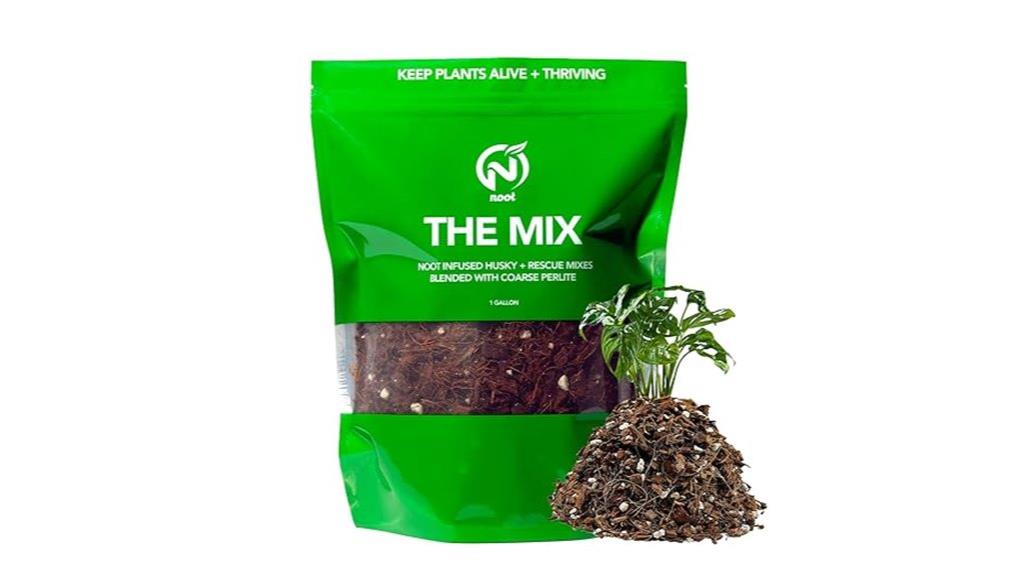
Noot Potting Soil Mix is an excellent choice for indoor and houseplant enthusiasts looking to boost their plant's health and growth. This bio-organic blend, featuring coconut chips, fibers, and perlite, guarantees superb airflow for roots. I've noticed rapid root development and vibrant blooms in my plants since using it. The unique microbial consortium really enhances nutrient absorption. While some users mention concerns about the price and occasional odor, I find the benefits outweigh these drawbacks. If you want to revive struggling plants or promote new growth, I highly recommend giving Noot a try for your indoor garden!
Best For: Indoor and houseplant enthusiasts seeking to enhance plant health and stimulate growth.
Pros:
- Promotes rapid root growth and vibrant blooms due to its bio-organic composition.
- Enhances nutrient absorption through a unique microbial consortium.
- Supports the recovery of struggling plants and fosters new growth.
Cons:
- Some users find the price to be high for the bag size.
- Occasional unpleasant odor reported by a few users.
- Presence of bugs in the mix has been noted by some customers.
Monstera Houseplant Potting Soil Mix (30 Quarts)
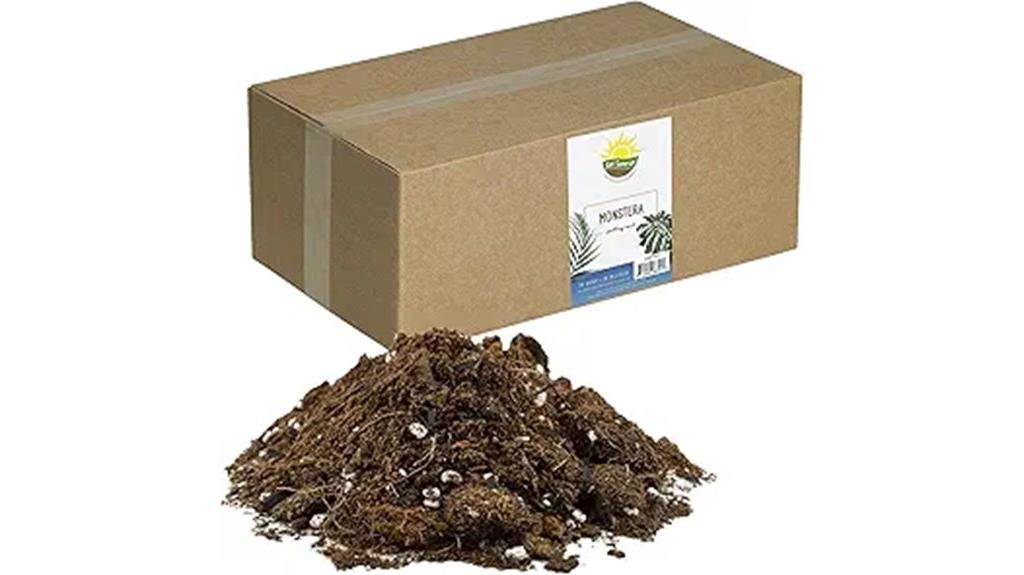
When it comes to nurturing your Monstera plants, the Monstera Houseplant Potting Soil Mix (30 Quarts) stands out as an exceptional choice. This custom blend includes peat moss, perlite, coconut coir, and worm castings, ensuring a nutrient-rich environment for your plants. Weighing 15 pounds and designed for ideal aeration and drainage, it supports healthy root development and vibrant foliage. I love how versatile it is, perfect for planting or repotting. With a solid customer rating of 4.3 stars, I've noticed significant improvements in my Monstera's health since switching to this mix. Just remember to watch for overwatering!
Best For: Plant enthusiasts looking to grow and repot Monstera varieties like Swiss Cheese Plant and Thai Constellation in a nutrient-rich soil mix.
Pros:
- Custom blend specifically designed for Monstera plants, promoting healthy growth and development.
- Lightweight and well-aerated composition ensures excellent drainage and moisture retention.
- Positive customer feedback highlights noticeable improvements in plant health and vitality.
Cons:
- Some users have expressed concerns about soil texture and drainage issues.
- May require careful monitoring to avoid overwatering, which can lead to root rot.
- Limited versatility for plants other than Monstera varieties.
Royal Gold Planting Medium Mix (1.5cu ft)
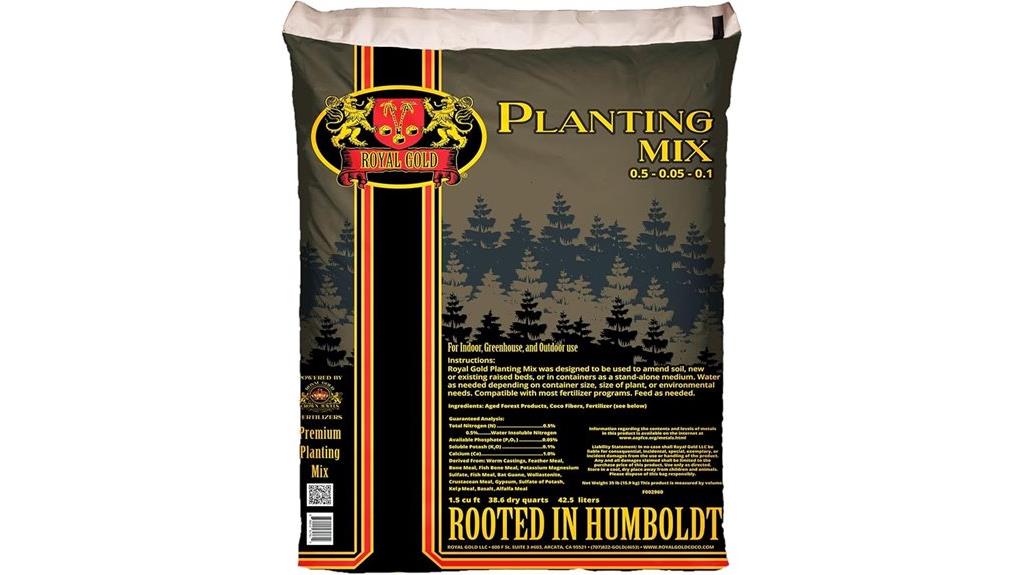
Royal Gold Planting Medium Mix (1.5 cu ft) stands out as an excellent choice for gardeners looking to enhance their soil without relying on perlite. This versatile mix combines aged forest products and coco fiber with organic fertilizers like worm castings and fish meal, ensuring long-term nourishment for your plants. I've found it perfect for raised beds and garden revitalization, thanks to its excellent permeability and moderate water retention. The balanced composition supports root health and boosts nutrient uptake, making it a reliable option for any gardening project. Give it a try, and watch your plants thrive!
Best For: Gardeners seeking a high-quality, perlite-free planting medium for raised beds, soil amending, and garden revitalization.
Pros:
- Excellent permeability and moderate water retention support healthy root growth.
- Contains a balanced mix of organic fertilizers for long-term soil nourishment.
- Versatile enough for various gardening applications, including beautification projects.
Cons:
- May be heavier to handle due to its 37-pound weight.
- Limited availability may affect access in certain regions.
- Pricing feedback from customers could indicate fluctuations in cost.
Factors to Consider When Choosing Soil Mixes
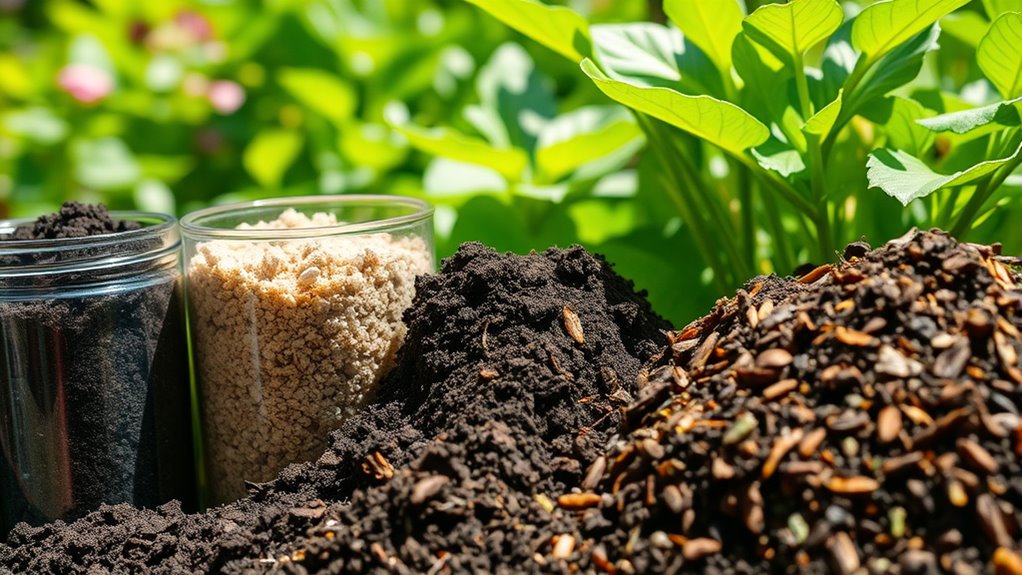
When I choose soil mixes, I always consider the type of plants I'm growing to guarantee compatibility. It's also essential to think about nutrient composition and how well the mix retains moisture while providing proper drainage. Finally, I try to prioritize environmentally sustainable options to support my gardening practices.
Plant Type Compatibility
Choosing the right soil mix for your plants is essential, especially since different species have unique needs. For instance, tropical plants like Monstera and Philodendron thrive in well-draining mixes that enhance aeration and root health. If you're growing succulents or cacti, opt for a mix that promotes excellent drainage to prevent root rot. On the other hand, vegetables and herbs benefit from nutrient-rich potting soils packed with organic materials. If you're considering shady wildflower mixes, verify they have the right balance of nutrients and moisture retention for low light conditions. Finally, if you practice organic gardening, look for mixes that are free from synthetic chemicals and include natural components like coconut coir and worm castings to support healthy growth.
Nutrient Composition Importance
Understanding plant type compatibility sets the stage for recognizing the significance of nutrient composition in soil mixes. Nutrient composition is essential for plant health, affecting growth, flowering, and overall vigor. Key elements like nitrogen, phosphorus, and potassium play important roles in this process. I've found that adding organic components, such as worm castings and compost, enhances nutrient availability and microbial activity, leading to a healthier root system. Maintaining a balanced pH level, ideally around 6.0, is critical for ideal nutrient uptake. Additionally, choosing soil mixes with slow-release fertilizers can provide a sustained nutrient supply, reducing the need for frequent feeding. Incorporating beneficial microbes helps improve nutrient absorption and promotes a thriving soil ecosystem.
Drainage and Aeration Needs
Three vital factors to contemplate for healthy plant growth are drainage, aeration, and moisture balance in soil mixes. Well-draining soil is fundamental to prevent overwatering and root rot, allowing excess water to escape and air to circulate around the roots. I've found that incorporating materials like perlite, pumice, or coarse sand greatly improves aeration, promoting robust root systems. A chunky texture, achieved with ingredients like lava rock or bark, further enhances drainage and helps maintain that essential moisture balance. For tropical plants, aiming for a soil pH around 6.0 mimics their natural conditions and guarantees nutrient availability. Finally, I regularly monitor moisture levels to guide my watering practices, making sure my plants stay hydrated without becoming waterlogged.
Environmental Sustainability Practices
While I explore the best soil mixes for my plants, I always consider the environmental impact of my choices. I prefer peat-free mixes to help reduce carbon emissions and protect biodiversity by preserving natural peat bogs. Using organic materials like coconut coir and worm castings not only supports sustainable practices but also boosts soil fertility without harmful chemicals. I also love incorporating natural volcanic rocks or pumice, as they improve drainage and aeration while being eco-friendly. Prioritizing non-GMO ingredients fosters healthier ecosystems and minimizes chemical runoff. Finally, I opt for compost-based mixes, which contribute to waste reduction and promote a circular economy by transforming organic matter into nutrient-rich growing mediums. These choices make my garden thrive sustainably.
Moisture Retention Capabilities
When selecting a soil mix, considering moisture retention capabilities is essential for keeping my plants healthy and thriving. The right mix holds water effectively, ensuring my plants stay hydrated between waterings. I've found that soil mixes with coconut coir or organic matter work wonders for moisture retention, while also reducing the risk of root rot from overwatering. It's equally important to include materials like perlite or pumice, which enhance drainage without sacrificing aeration—something my plants' roots need. Since different plants have varying moisture needs, I tailor my soil mixes accordingly. Regularly checking soil moisture levels helps me gauge how well my chosen mix retains water, leading to ideal growing conditions for my garden.
Frequently Asked Questions
How Do I Store Leftover Potting Soil for Future Use?
I often find myself with leftover potting soil after replanting. To store it, I place it in a clean, airtight container or a heavy-duty plastic bag. I make sure to keep it in a cool, dry place to prevent any mold or pests from developing. Before using it again, I always check for any clumps or signs of deterioration. With this method, my leftover soil stays fresh for my next gardening project!
Can I Mix Different Soil Types Together?
Mixing different soil types is like creating a magical potion for your plants! I've had great success blending potting soil with garden soil or compost. It boosts drainage and nutrients, giving my plants a thriving environment. Just remember, balance is key. Too much of one type can throw it off. I've experimented and found that a 50-50 mix often works wonders. So, don't hesitate to mix and see what your plants love!
When Should I Repot My Plants Into Fresh Soil?
I usually repot my plants into fresh soil when I notice their growth slowing down or if roots are poking out of the drainage holes. It's also a good idea to repot if the soil looks compacted or has lost its nutrients. Generally, I aim to do this every 1-2 years, but it really depends on the plant's needs. Keeping an eye on them helps me know the right time.
How Can I Tell if My Soil Is Too Compacted?
Figuring out if my soil's too compacted is like trying to squeeze a sponge that's already full of water. I poke my finger into the soil; if it feels hard and doesn't easily break apart, it's likely compacted. I also check for poor drainage or if water pools on the surface. My plants might show signs of stress too, like wilting or stunted growth, which signals it's time to address the soil issue.
What Are Signs of Nutrient Deficiency in Potting Soil?
When I notice signs of nutrient deficiency in my potting soil, I look for a few key indicators. My plants might show yellowing leaves, stunted growth, or even leaf drop. Sometimes, I see dark spots or browning edges, which can signal a lack of essential nutrients. I've learned to pay attention to these changes, as they often mean it's time to amend my soil to keep my plants healthy and thriving.
Conclusion
In the grand garden of life, choosing the right soil mix is like picking the perfect companion for your plants' journey. Each blend offers a unique embrace, nurturing growth and energy. Whether you're cultivating indoor wonders or blossoming outdoor delights, these mixes are your silent partners in success. So, as you dig deeper into your gardening adventure, remember that the right foundation can turn a humble seed into a thriving masterpiece. Let your garden flourish!
